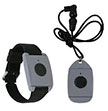The Right Provider Company Is Just As Important As The Right System
Independent living seniors, family member caregivers and health care professionals alike, are all basically familiar with emergency medical alert systems and the medical alert necklace that summons emergency assistance when a sudden or unexpected accident or medical event occurs. Finding the right system that offers the best in affordability, product technology and monitoring services for you or a loved one can be a confusing and sometimes overwhelming process. Yet, choosing the right system provider is just as critical as finding the right system technology and devices. Put differently, the best system in place is only as good as the provider company that supports it….the following key points is what you need to consider.
System Equipment Selection
The provider company should offer consumers a complete selection and varietal range of systems to suit the specific needs of any standard user (i.e. independent senior, medical ailment, disabled, at-risk employee, etc.). For older adult users, land line and cell dialer systems for in and around the home are reliable and effective. For individuals who require portability and mobile protection outside the home, GPS and cellular network mobile care systems are most suitable. Accessories that augment a system such as wearable buttons, hallway buttons, lock boxes, and home safety lighting products are also highly recommended.
Purchase and Rental Price Plan Options
Rental plans for these systems is the most advisable and affordable payment method. Purchase of a particular systems might be an advisable option if the user intends to employ the system for an extended period of time- say five to seven years or more. Rental price plans should include a Monthly, Quarterly and Annual payment plan option. The more you pay for an installment (i.e. Quarterly or Annual), the cheaper the monthly rate should be. In other words, different monthly rates for different rental price plans. These rates should combine the equipment and emergency monitoring service fees all into one (monthly) rate commensurate with the rental plan selected.
Hidden Fees and Charges
When possible, try to stay away from provider companies that charge “one-time” service and handling fees such as an Activation Fee, Programming Fee, Cancellation or Termination Fee and the like. These “one-time” individual charges can range from $50.00 to $250.00. To note, an Activation Fee (under $100.00) can be necessary for providers when offering more advanced technologies and applications like a GPS mobile-based system.
24/7 Emergency Monitoring Service
The emergency monitoring center should provide nationwide coverage and reliable response/dispatch services on a 24-hour, seven-day-per-week basis. Emergency Center responders should only be live operators, not voice mail or via phone line response are industry certified in emergency medical services (EMS) response and dispatch. Spanish-speaking operators should also be provided to users, if needed.
Customer Service and Support
The provider company should offer responsive customer service and support to users and their family member caregivers on a 24 hour, seven-day-a-week basis. Contact with customer service should be easily accessible through a toll-free number, e-mail and a web site link. In the event call volume prohibits a live response over the phone, leave a message and that non-emergency call should be returned within 1 to 2 hours.
Customer Reviews and Satisfaction Performance Rating
With online shopping at record levels, customer reviews are being sought by potential buyers as independent, non-biased “truth barometers” on a company’s products and services. Take the time to visit the company provider web site and other independent, reputable sources for reviews on particular companies and their ratings for customer satisfaction and performance.
Company Profile and History
Choose a company that is a nationwide provider of medical alarm systems and emergency monitoring services. Local providers usually do not have the infrastructure, monitoring capability and financial viability to professionally service these industry clients.
Other criteria include a reputable, quality-based provider company that has a successful business history of at least 5 to 7 years in the medical alarm industry, a Better Business Bureau rating of “A-” or better in the state the company is headquartered, and one that specializes in emergency medical alarm (i.e. does not bundle this specialized service with residential home security and the like) and related services. A content-rich, informative and easy to navigate web site is also a tell-tale sign that the provider company is a highly professional and dedicated member of the medical alarm industry.









 “I am very uneasy and have had many falls after my surgery. Ordering the First Response system was easy and I even set it up myself. I have had to use my alert button a few times so far. My daughter has even been contacted after I had taken a few falls. My First Response system has worked great each time I’ve needed it!”
“I am very uneasy and have had many falls after my surgery. Ordering the First Response system was easy and I even set it up myself. I have had to use my alert button a few times so far. My daughter has even been contacted after I had taken a few falls. My First Response system has worked great each time I’ve needed it!”